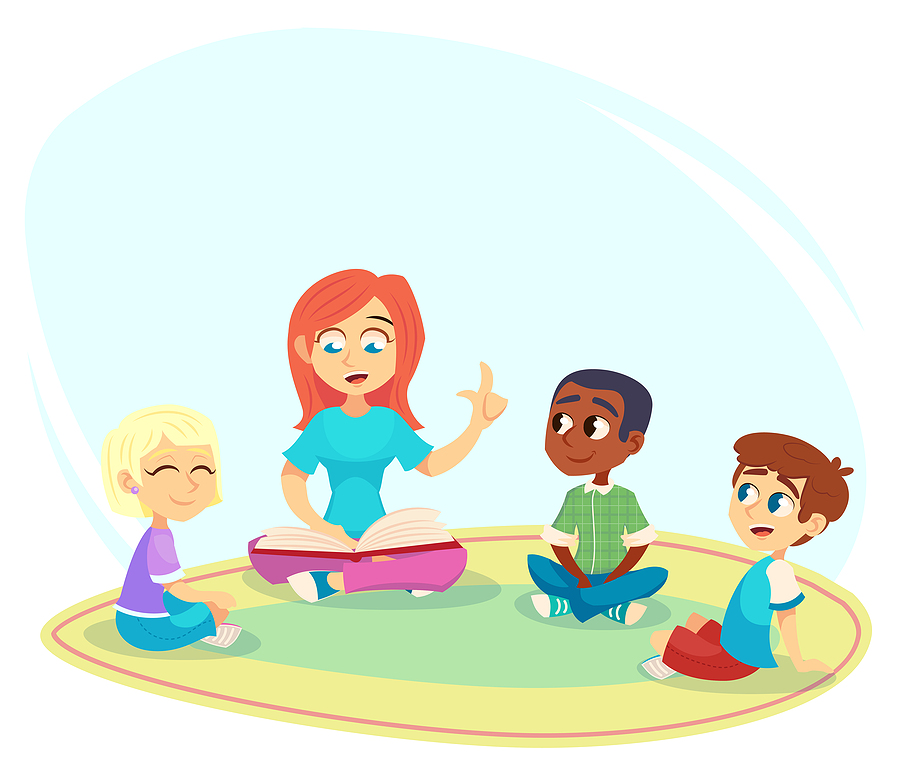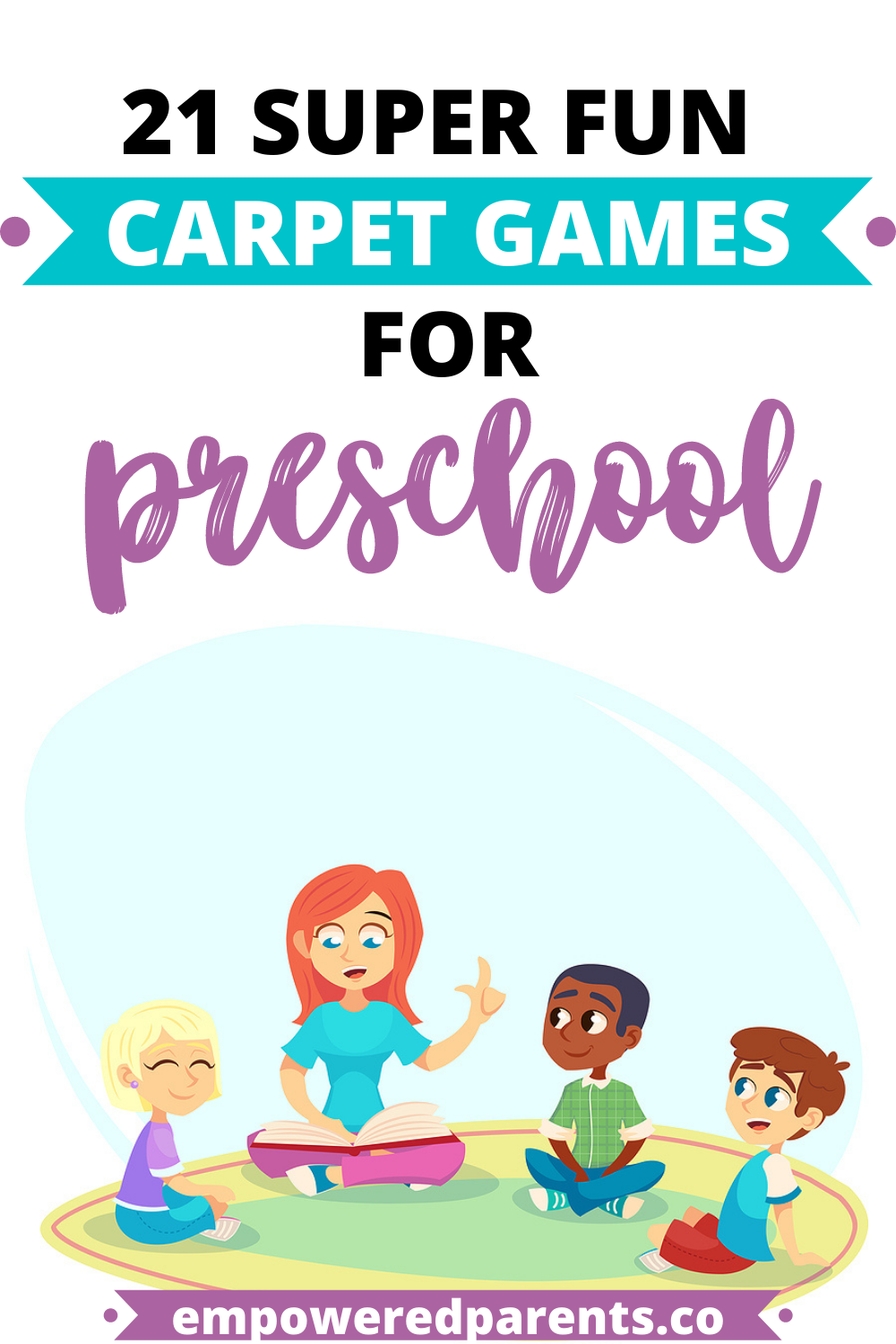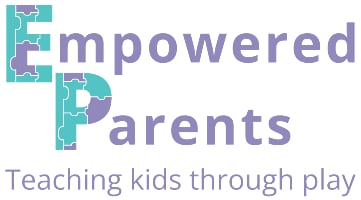Playing carpet games with preschoolers and kindergarteners is a wonderful circle-time activity.
It’s also a good way to wind them down at the end of the day, to teach kids a particular skill (such as listening or memory), or to use as a transition activity or brain break.
Here are 21 of the best circle-time games. Adapt these games to suit the age and maturity of your kids.
Some of these games have been around for many years and you probably played them as kids.
There’s also a handy printable of these games at the end of this post.
1. Broken Telephone
An old favourite, Broken Telephone or The Telephone Game is a good way to teach listening skills.
- Kids sit in a circle and one whispers a word or short phrase into the next child’s ear.
- The message gets passed around from person to person until it reaches the last child.
- The last child must say out loud what the message is, revealing if the message was passed intact or if it was changed along the way.
Here is a list of Telephone game phrases to use for this game.
2. Would You Rather?
This game will develop kids’ critical thinking skills.
- Give kids an option of two choices and ask them ‘Would you rather…’
- They must choose one and explain or justify their reasoning.
- Some examples are choices of things they would rather be, see, experience, live in, have, etc.
Here are some great Would You Rather questions for kids.

3. Pass the Parcel
This is a typical circle game for kids that is fun for parties as well as to play in class.
- Wrap a prize or small token in multiple layers of wrapping paper.
- For young kids, place enough gifts for everyone in a packet or box and wrap that.
- Play music as kids pass the parcel around the circle.
- When the music stops, whoever is holding the parcel must unwrap a layer.
- The child who unwraps the last layer wins the prize or hands out the prizes to everyone.
Try these Pass the Parcel ideas.
4. I Spy With My Little Eye
This game teaches kids to think and also to formulate clues (riddles) and find the words to describe something without giving it away.
- One child begins by saying “I spy with my little eye” and then describes the object.
- Whoever guesses the object wins and can choose an object for the next round.
You can use a game of I Spy to teach colour recognition, number recognition, visual perception, positional language and much more.
It also makes a great alphabet carpet game if kids give clues such as I spy with my little eye something beginning with an “s”.
Here are 72 I Spy With My Little Eye examples.
5. Rock, Paper, Scissors
This game will teach kids to think quickly.
Pair kids up or get them to turn to the child sitting next to them to play a game. They can then turn to their other side to play a game with the child sitting on that side.
Teach them what the different actions look like in Rock, Paper, Scissors and also what they can do:
- Rock crushes scissors
- Scissors cuts paper
- Paper covers rock
Here are the rules of Rock, Paper, Scissors.
6. Musical Statues
Musical Statues is a game that works well indoors but also makes a good outdoor game.
- Tell kids to dance on the spot in a circle while you play music in the background.
- When the music stops, everyone must freeze like a statue.
- Since kids will all be facing each other, they can be responsible for pointing out anyone who moves and therefore has to sit down.
- The last child standing is the winner.
7. Categories Game
This game helps develop kids’ vocabulary and memory.
- Pick a category such as cars, sweets, colours, etc.
- Go around the circle giving each child a turn to add a word to the list that fits in the category.
- No one is allowed to repeat a word that was already stated.
- If someone repeats a word or can’t think of a word, the round ends and the next round begins.
- Count how many words the group thought of and try to beat it on the next round.
Make the categories broad and simple for younger kids and challenging for older kids. Try these fun category games.
8. Matching Game
This game requires kids to physically find their matching partner.
- Make pairs of matching picture cards.
- Hand a card to each child and have the kids walk around, finding their matching partner.
- Once they’ve found their partner, they can sit together.
- The first pair to sit are the winners.
For the cards, use simple images you can draw, shapes, letters or even colour cards for young kids.

9. Duck, Duck, Goose
Duck, Duck, Goose may not be the best option for indoors but if you have a fairly large carpet area and younger children, it will be just as fun.
- The kids sit in a circle and one child is chosen to be “on”.
- That child goes around the outside of the circle, tapping each child on the head. He calls each child “duck” as he taps them.
- The child chooses one child to be the goose and instead of saying “duck”, taps that child on the head and says “goose”.
- The goose must stand up and chase the person who tapped him around the circle, attempting to touch him before he sits down in the open spot.
- If he sits down in time, the goose then has a turn to walk around saying “duck, duck, duck, goose.”
10. Kim’s Game
Kim’s game can be played to help children improve kids’ visual memory.
- Place a few items on a tray and show them to the group.
- Give kids a while to look at the items and tell them to remember what they have seen.
- Then, cover the tray and ask the kids what items were on the tray.
- If playing with a large group, place lots of little objects on the tray and go around the circle, giving each child a turn to name something that was on the tray.
- As a variation, remove one item and uncover the tray and see if the whole group can try to think which single item is missing from the tray.
11. Make Up a Story
Develop kids’ imagination and language skills by making up a story as a group.

- Start the round by giving an introduction sentence such as “There was once a small, brown bear who lived in a big house”.
- Then, go around the circle giving each child a turn to add a line to the story.
The story may develop into a nonsense story or it may be quite a funny plot, but either way, it will be lots of fun and have the kids in stitches.
This is challenging for small kids so give a few examples or try it with older children.
12. Who’s Got the Button?
To play Button, Button, Who’s Got the Button:
- Children sit in a circle with their eyes closed, holding out one hand.
- A teacher or child goes around the circle pretending to place a button in everyone’s hand.
- She must place it in one child’s hand.
- Everyone opens their eyes and must then guess as a group who looks the guiltiest and is holding the button.
- The person who guesses right will hide the button in the next round.
13. Copycat
Copycat is a fun variation of Follow the Leader game but requires that children guess who the leader is.
- Children sit in a circle and one child is sent out of the room. That child will have to guess who the leader is.
- Choose one child in the circle to be the leader and call the “guesser” back inside.
- The leader then performs actions that the whole group copies, while the guesser tries to figure out who is leading all the actions.
- If the guesser gets it right, the leader then becomes the guesser in the next round and a new leader is chosen.
14. Hot Potato
Hot Potato is a classic circle game, played with a ball, beanbag or anything else to represent a potato.
- While music is playing, children pass the object around the circle, pretending it is a hot potato that will burn their hands.
- They must pass the potato quickly, but if they drop it they are out.
- When the music stops, the person holding the potato is out.
- The last person is the winner.
This game is great for building eye-hand coordination. Here are some variations of the Hot Potato game.
15. Keep the Chain Going
This game builds memory as children have to remember a string of words and add their own to the list.
Play a game of “I went to went to the zoo and I saw a…” or ‘I went to the shop and I bought a…”
- One child starts the chain by saying something like “I went to the shop and I bought bananas.”
- The next child repeats, adding their own word to the list: “I went to the shop and I bought bananas and strawberries” and they continue until the last person recalls the items of every single child in the circle.
While this game is challenging, I have played it with 5-year-olds who have remembered the entire string of words.
As they watch each child think of their own word to add, they learn to associate that word with the child, especially if they giggled when they said it, took a long time to find the word or did anything else that would help imprint the word into other kids’ memory.
Here are more memory games for children.
16. Simon Says
Build kids’ ability to follow instructions with a game of Simon Says.
- An adult or child is “it” and must perform actions while saying “Simon Says…”
- If the command begins with “Simon Says,” children must carry out the action. If the person does not say “Simon Says,” but merely does the action, kids must not repeat it or they will be “out.”
- The last person still “in” at the end is the winner.
Here are some fun Simon Says Ideas.

17. Who Am I?
For this game, each child gets a turn to impersonate an animal or character without making a sound.
The children must guess who they are.
They could act out their favourite animals or creatures (real animals, dinosaurs, etc.), or people in various scenarios ( a crying baby, a teacher or a builder).
18. Odd One Out Game
Great for building thinking skills and learning to categorize and group, play Odd One Out with your kids.
- Pick any category in your mind and say a list of about four items, three of which fit into the category and one which doesn’t.
- An example is orange, banana, cake and blueberries.
- Kids need to identify the word that doesn’t fit and also the “rule” that the others follow, such as “it’s a fruit.”
Here is a list of ideas to play the Odd One Out Game. The categories can be as broad or as challenging as necessary for the age of the kids.
19. Rhyming Game
Teach kids to rhyme with this simple game:
- Pick a word that’s easy to rhyme with, such as “cat.”
- Let each child have a turn to add a word that rhymes to the string of words.
- The only rule is they can’t repeat a word that’s already been used.
- For older children, make a rule that they may only use real words but for younger children, encourage making up rhyming nonsense words to get them used to hearing rhyming sounds.
Start a new round when you run out of ideas.
20. Riddles
Riddles are challenging to tell and to figure out but are a great exercise for young kids.
- Take turns telling simple riddles to the group.
- Example: I am fierce, I have a mane and 4 legs. What am I?
- Whoever guesses first can tell the next riddle.
This teaches kids to use descriptive language well.
21. Action Words
For this last circle game for preschoolers, teach kids about action words (verbs).
- Choose an animal or person and say “A bird can fly” or give any other action that could be true for that person or animal.
- Then give each child a turn to think of another verb that’s true, such as “a bird can sing,” “a bird can sleep,” “a bird can hop,” or “a bird can eat.”
- If someone says something that’s not true (such as “a bird can cook”), the child must have another go and choose a new verb.
See how many verbs you can think of for each round.
I hope you’ll enjoy trying out these carpet time activities with your children. If you need more ideas, check out this list of the most fun games to play with kids.
Carpet Games for Circle Time
Notes
Broken Telephone
Whisper a word or phrase around the circle. The last child says it aloud – did it stay the same?
Would You Rather?
Ask questions like “Would you rather be a lion or a bird?” Children choose and explain why.
Pass the Parcel
Wrap a prize in layers. Kids pass the parcel while music plays. When the music stops, unwrap one layer. Continue until the prize is reached.
I Spy With My Little Eye
A child gives clues about an object in the room. Others guess what it is. Try variations like colour or letter clues.
Rock, Paper, Scissors
Teach the actions and have kids play in pairs. Rock beats scissors, scissors beat paper, paper beats rock.
Musical Statues
Dance when music plays, freeze when it stops. Anyone who moves is out. The last one standing wins.
Categories Game
Pick a category (e.g. animals). Go around the circle naming items in that category. No repeats!
Matching Game
Hand each child a matching card and have them walk around to find their partner.
Duck, Duck, Goose
Kids sit in a circle. One child walks around saying “duck, duck…” then “goose!” The goose chases them back to their spot.
Kim’s Game
Show kids a tray of items. Cover it and ask them to recall what was on it – or remove one and guess what’s missing.
Make Up a Story
Start a story with a line like “Once there was a bear…” Go around the circle, each child adds a sentence.
Who’s Got the Button?
Children sit in a circle with closed eyes and one child hides the button. The group guesses who has it.
Copycat
One child leaves the room. A leader is chosen to perform movements everyone copies. The guesser returns and tries to figure out who the leader is.
Hot Potato
Pass an object while music plays. When it stops, the child holding the “potato” is out. The last child wins.
Keep the Chain Going
Memory game: “I went to the shop and I bought…” Each child repeats the list and adds their own item.
Simon Says
Give commands that begin with “Simon says…” Kids must only follow the instructions if you say “Simon says” first.
Who Am I?
A child silently acts out an animal or person. Others guess who they are pretending to be.
Odd One Out
Say a list of items – e.g. orange, banana, cake, grapes. Children guess which doesn’t belong and why.
Rhyming Game
Pick a rhyming word (e.g. “cat”) and go around the circle adding rhyming words (real or made-up).
Riddles
Tell simple riddles: “I have a mane and four legs. What am I?” Take turns making up or guessing riddles.
Action Words
Pick a subject, like “a bird.” Children take turns saying verbs: “A bird can fly,” “A bird can sing,” etc.


Brenda
Sunday 12th of January 2025
I would love to have your free download of the 21 Super fun carpet games. I plan to use them mostly at the end of the day to calm my pre schoolers down. Thank you.
Karen
Monday 9th of September 2024
thanks
Tanja McIlroy
Monday 9th of September 2024
You're welcome!